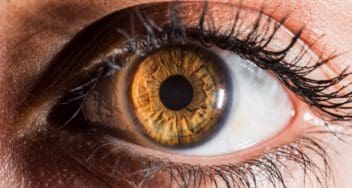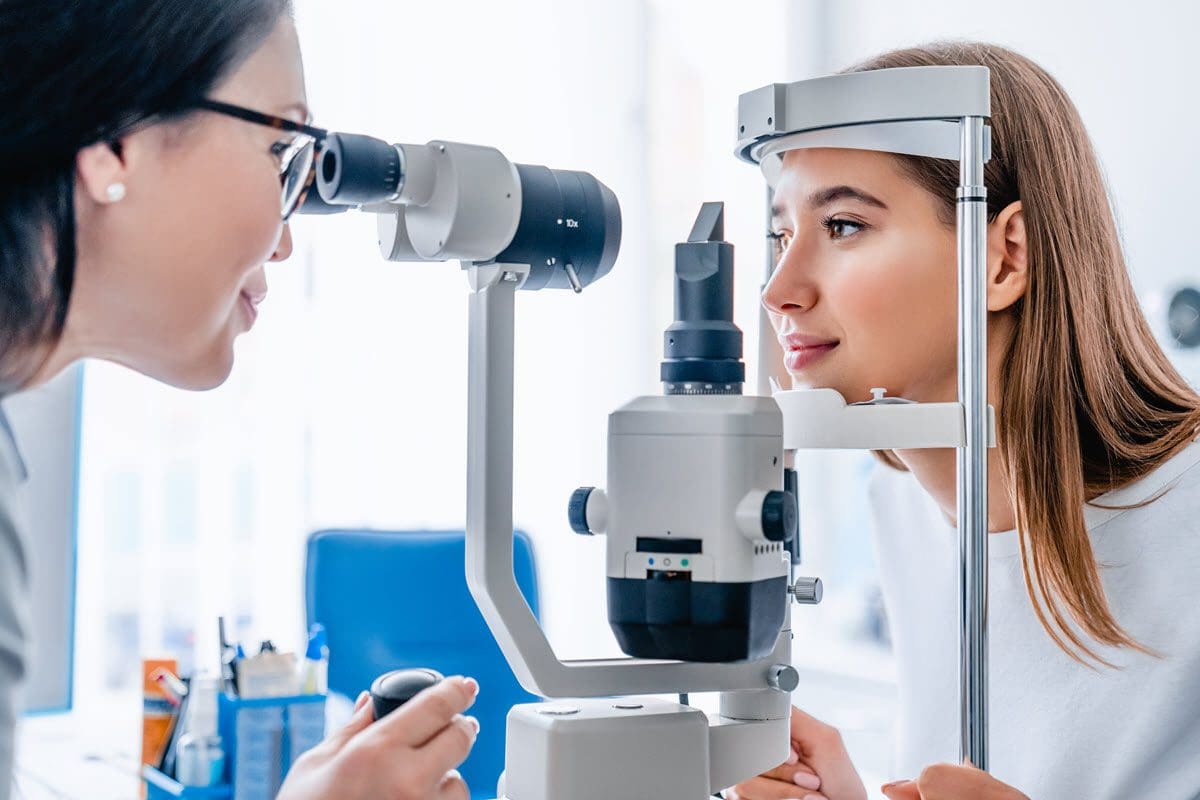SMILE Laser Eye Surgery
Home / Laser Eye Surgery Guide (Updated) /
Last Updated:

Article At a Glance
Small incision lenticule extraction (SMILE) is a form of laser eye surgery. People with myopia (nearsightedness) can benefit from this procedure. During SMILE, doctors cut a disc-shaped piece from the cornea and remove it, reshaping your cornea.
Table of Contents
What Is SMILE Eye Surgery?
SMILE is a laser eye surgery that corrects myopia (nearsightedness). Recently, doctors have used the surgery to treat astigmatism too. The FDA approved the procedure in 2016, making this one of the newest eye surgeries available.
Laser eye surgeries like SMILE involve reshaping the eye to correct common refractive errors. People who have myopia (nearsightedness), hyperopia (farsightedness), and astigmatism (blurred vision) can get permanent relief through laser eye surgery.
You deserve clear vision. We can help.
With 135+ locations and over 2.5 million procedures performed, our board-certified eye surgeons deliver results you can trust.
Your journey to better vision starts here.
A recent survey found that about 40% of the United States population has some degree of myopia. Many more have astigmatism. In the past, they had to wear glasses or contacts for relief. Laser surgeries changed all this.
While SMILE is new, it offers remarkable results. More than 95% of patients are satisfied with their results from SMILE eye surgery.
Key Facts About SMILE Laser Surgery

- Unlike LASIK, SMILE corrects your vision permanently without creating a corneal flap.
- SMILE was approved by the U.S. Food and Drug Administration (FDA) in 2016 for people 22 and older who are nearsighted.
- More than 95% of patients are satisfied with their results from SMILE surgery.
- SMILE recovery is quick, and most people return to work the next day.
Who Qualifies for SMILE Eye Correction?
Although many people can benefit from SMILE, just like millions of people have benefitted from LASIK, there are still some individuals who are not good candidates for this laser procedure.
Good candidates for SMILE meet the following characteristics:
- You are at least 22 years old.
- You do not have consistently changing vision for at least a year.
- You have no other vision problems like cataracts or glaucoma.
- You have healthy corneas overall.
- You have a nearsightedness prescription between -1.00 and -10.00 diopters in power, with no more than -8.00 diopters being ideal.
- You have an astigmatism of -0.75 to -3.00 diopters.
- You have a total prescription, combining astigmatism and nearsightedness, that does not exceed -10.00 diopters.
- You are not pregnant or nursing.
You may not be a good candidate for SMILE if you meet these characteristics:
- You have an unstable refractive error that changes more than -0.50 diopters in a year.
- You have hyperopia or presbyopia, two types of farsightedness.
- You have a condition that affects how quickly you heal.
- You are pregnant or nursing.
- You have uncontrolled diabetes.
- You have excessive scarring or keloid formation.
- You have keratoconus, or an unusual bulging shape to your cornea.
- You have a corneal disease or corneal abrasions.
- You have advanced glaucoma.
- You have a cataract impacting your vision.
- You have thin corneas.
- You have a history of eye disease or certain infections.
- You have had laser surgery on your eyes in the past.
The best determinant of whether SMILE is right for you is to consult with an eye care professional, who can provide a comprehensive evaluation based on your unique eye health and vision needs.
What to Expect When Getting SMILE
Understanding how your SMILE surgery will work can help you feel more confident and in control of your decision and recovery.
This operation is well understood, with many clinical studies determining its safety and effectiveness for specific people. On average, about 99% of people who undergo SMILE have 20/40 vision at their six-month follow-up appointment, and 88% have 20/20 vision at that point.
Your surgery is safe and effective. Here’s what you need to know in advance.
- Ensure your candidacy. SMILE is safe and effective, in part, because the procedure is only performed on people who meet stringent requirements. Your doctor will perform a comprehensive eye exam and confirm that you don’t have issues such as glaucoma.
- Answer your questions. You’ll discuss your concerns and expectations, so you understand what to expect in terms of healing times, risks, and other factors.
- Map the eyes. Special tools take measurements of your cornea, so the doctor can program the laser appropriately during the surgery.
- Help you prepare. As part of your consultation, your doctor will explain what you should and shouldn’t do to prepare for your surgery.
You can always get a second opinion from another professional, just to ensure you answer your questions appropriately.
During the Procedure
Understanding how SMILE works can help you feel more comfortable when the surgery day arrives.
SMILE takes between 10 and 15 minutes per eye. The laser will be programmed with the map of your eye, and your surgeon will numb your eye with drops. Your eyelids will be held back with a special holder, so you do not blink, but the guided laser also has protective measures in place to manage any twitching you do during surgery.
Once you are in place, a suction ring will be placed on your cornea, which will also prevent your eye from moving.
Using a femtosecond laser, your ophthalmologist will create a small lens-shaped disc (a lenticule) in your cornea. That disc is removed via an incision (2 mm to 3 mm wide) in your cornea. Your cornea flattens in response. Light is then refracted more clearly onto your retina.
Recovering From SMILE Surgery
Your vision should recover within about two days after SMILE. Full recovery can take longer, from 10 days to a month.
While your eyes start healing immediately after SMILE, you’ll need someone to drive you home from surgery. Rest your eyes when you get home, and avoid taxing activities (like using computer screens or doing close work).
Your doctor will give you a detailed plan for recovery. But expect to use eye drops for several days, and some people need oral pain medication too. You may experience short-term vision issues like blurriness and halos around lights as your eyes heal and swelling from surgery fades.
You deserve clear vision. We can help.
With 135+ locations and over 2.5 million procedures performed, our board-certified eye surgeons deliver results you can trust.
Your journey to better vision starts here.
Side Effects & Risks of the SMILE Procedure
Common SMILE side effects are similar to those of LASIK or other laser-guided eye treatments. While usually temporary, potential side effects include the following:
- Glare
- Halos around lights
- Dry eye
- Debris at the site of tissue removal
- Inflammation in the tissues
Unlike other laser procedures (such as LASIK), SMILE doesn’t involve creating a flap. You won’t have to worry about the flap being displaced by contact sports or a heavy blow to the head. But you should still follow aftercare instructions and keep your eyes safe and clean.
Like other laser eye procedures, there is a risk of overcorrection or undercorrection with SMILE. If your surgery results in undercorrection, you may need corrective lenses like glasses. If your surgery results in overcorrection, you may need another procedure.
NVISION Eye Center doctors take patient safety very seriously. We examine all of our patients carefully, and candidacy issues are carefully weighted when determining which corrective procedure matches your goals.
How Much Does SMILE Eye Surgery Cost?
The cost of SMILE eye surgery is $2,000 to $3,000 per eye. As SMILE becomes more popular, and it becomes easier for ophthalmologists to get the right training and equipment, the cost of the operation is going down. According to Market Scope U.S. Refractive Surveys (2019), the cost of SMILE has decreased from about $4,290 in 2016 to $2,361 in 2019.
Financing options can put the cost of surgery within reach. They include the following:
- Vision and health insurance: Some plans offer discounts and other benefits that could help to reduce the cost of surgery.
- Flexible spending account (FSA) or health savings account (HSA): These programs allow you to put aside pre-tax dollars to pay for health expenses.
- Provider discounts: Many surgical practices also offer discounts or flexible payment plans.
- Loans: Sometimes, patients take out small loans or use low-interest credit cards to cover the costs of these operations.
Eye correction can be affordable, especially when you combine your payment options. Evaluate all of your options before making any decisions.
What Is the Difference Between SMILE & LASIK?
LASIK eye surgery and SMILE both involve using lasers to reshape the cornea and offer permanent vision correction. But important differences exist.
LASIK involves creating an incision in the cornea and lifting the tissue (a flap). Lower layers are reshaped via lasers, and the flap is replaced. SMILE uses no flap, but involves removing tissue from the cornea via an incision.
Both procedures are FDA approved with high success rates and long-term permanent vision correction. Your doctor can help determine which procedure is right for you and help you understand SMILE compared to LASIK.
| SMILE | Custom LASIK | |
| How it works | Doctors remove a small piece of your cornea via a tiny incision. | Doctors reshape lower layers of your cornea (accessed via a flap) with a laser. |
| Conditions treated | Nearsightedness and astigmatism are treated with SMILE. | Nearsightedness, farsightedness, and astigmatism are treated with LASIK. |
| Short-term Side effects* | Minimal chances for short term vVisual disturbances, inflammation, and infection are some side effects of SMILE. | Similar side effects to SMILE surgery, with a significant influence fromVisual disturbances, dryness, inflammation, and flap displacement are occasionalcommon side effects, depending on the quality of the surgeon and technology used.. |
| Cost | SMILE costs about $2,000 to $3,000 per eye. | Custom LASIK costs about $2,000 to $3,000 per eye. |
SMILE Eye Surgery Frequently Asked Questions
Yes. SMILE is an FDA-approved surgical procedure that is very safe.
No. Few patients experience pain during the SMILE procedure due to the medications used.
SMILE costs about $2,000 to $3,000 per eye.
SMILE eye surgery is different than LASIK, but one is not inherently better than another. Your doctor can help you determine which surgery is best for your vision issue.
You deserve clear vision. We can help.
With 135+ locations and over 2.5 million procedures performed, our board-certified eye surgeons deliver results you can trust.
Your journey to better vision starts here.
References
- FDA Approves VisuMax Femtosecond Laser to Surgically Treat Nearsightedness. (September 2016). U.S. Food and Drug Administration.
- Measuring Patient-Reported Outcomes After Refractive Surgery to Assess Patient Satisfaction. (June 2019). Eye News.
- The World Is Rapidly Becoming More Nearsighted. (February 18, 2016). Popular Science.
- The 25th Anniversary of Laser Vision Correction in the United States. (March 2021). Clinical Ophthalmology.
- Small Incision Lenticule Extraction SMILE – The Future of Refractive Surgery Is Here. (January–February 2018). Missouri Medicine.
- Refractive Results With SMILE Using Lower Energy Settings in the United States. (October 2021). PLOS ONE.
- Prospective, Randomized, Contralateral Eye Comparison of Functional Optical Zone, and Visual Quality After SMILE and FS-LASIK for High Myopia. (February 2022). Translation Vision Science & Technology.
- SMILE Procedure Expands Laser Vision Correction Options. (June 2022). Refractive Surgery Council.
This content is for informational purposes only. It may have been reviewed by a licensed physician, but is not intended to serve as a substitute for professional medical advice. Always consult your healthcare provider with any health concerns. For more, read our Privacy Policy and Editorial Policy.

